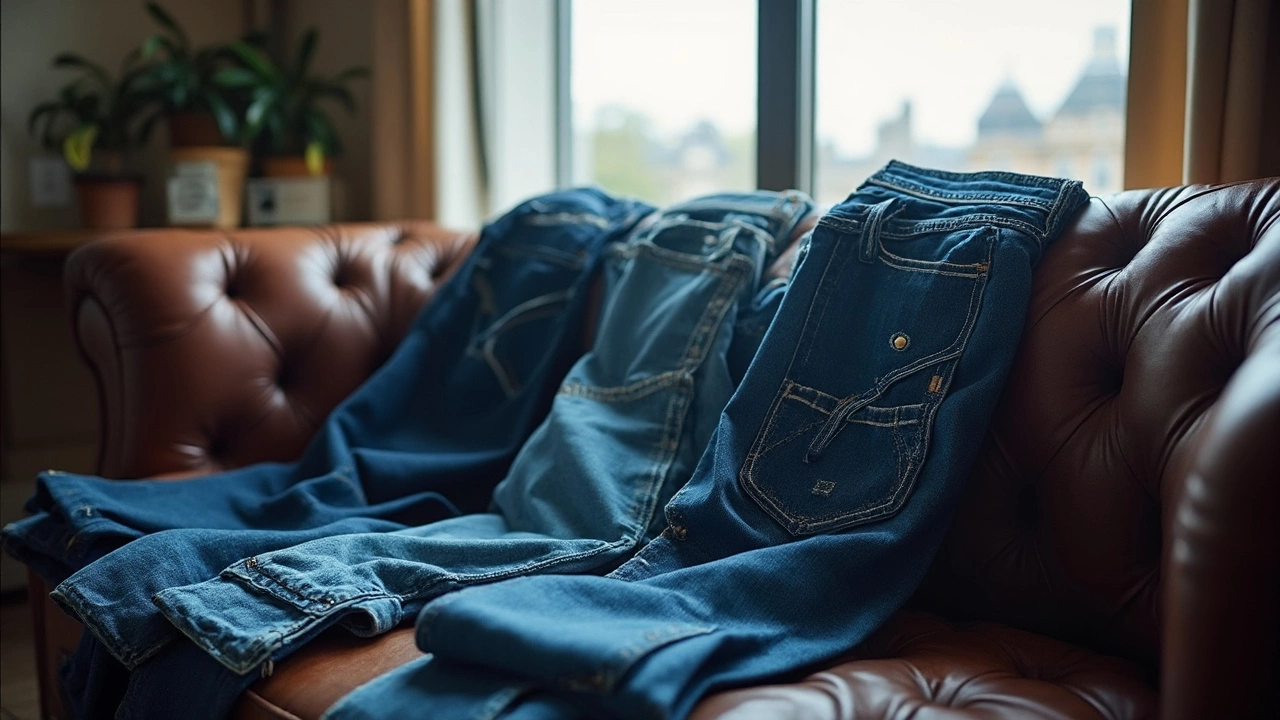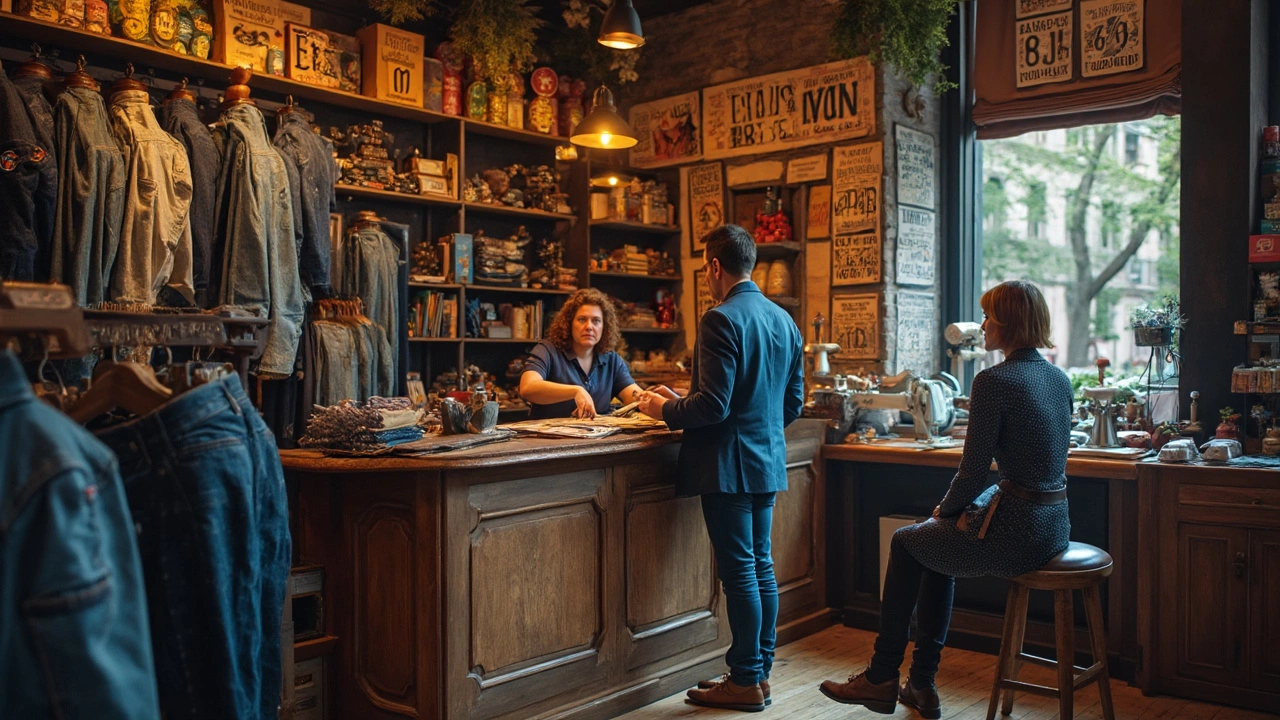Ever stood in front of a rack of jeans, perplexed over whether to splurge on those pricey pairs or stick with your usual budget-friendly find? You're not alone. The truth is, higher prices don't always mean better quality, but they do offer interesting clues about what you're buying.
First thing to consider: the fabric. Denim comes in various weaves and weights, and more expensive jeans often use premium materials that feel softer or are more durable. But here's the catch—not all of them do. Some cheaper brands may surprise you with quality materials too. It’s all about knowing what to look for.
Construction also matters. High-end jeans tend to boast precise stitching and reinforced seams. Check the hems and pockets, and if you're shopping online, read reviews for insights on durability. After all, nobody wants to be that person with torn jeans from a mild stretch.
- The Fabric Factor
- Craftsmanship Counts
- Brand Influence
- Identifying Quality Features
- Balancing Cost and Value
The Fabric Factor
When it comes to jeans, the fabric is one of the first things you should focus on. Most denim is made from cotton, but the way it's woven can really change its character. Let's break it down: basic denim is typically woven with a 'twill' pattern, which gives jeans that iconic diagonal ribbing. But did you know that some premium jeans blend in materials like stretch fibers or even silk to up the comfort and feel?
Spotting Quality Denim
Look for Japanese or Italian denim. Why? These countries are known for using slow weaving techniques that produce a tighter weave, resulting in more durable fabric. Japanese denim, for instance, often uses a technique called 'selvedge', which means the edges are woven to prevent unraveling. These jeans usually last longer, feel more substantial, and resist wear and tear.
Now, ask yourself if the jeans are 100% cotton or a cotton blend. Purists might lean towards all-cotton for that traditional, robust feel. But if you're after a bit of give, a blend with a touch of elastane might be more your style. Remember, not all expensive jeans are purely cotton, but a higher price tag could suggest more innovative blends.
Does Weight Matter?
Yes, it does! Denim weight is measured in ounces per square yard. Heavier denim, around 12-16 oz, is tougher and better for colder climates. Meanwhile, lighter denim, say 8-10 oz, is more breathable and great for warmer days. If you're investing in a high-priced pair, check if the weight matches your needs. No point in buying thick jeans if you live in a sunny area.
| Denim Type | Material | Advantages |
|---|---|---|
| Japanese Selvedge | 100% Cotton | Durability, traditional look |
| Stretch Denim | Cotton-Elastane Blend | Comfort, flexibility |
| Organic Cotton | 100% Organic Cotton | Eco-friendly, soft touch |
In the end, it’s about finding the right balance between how a denim feels and performs for what you're willing to spend. Price doesn’t always mean perfect, but understanding these details helps you make an informed choice. So next time you’re shopping for jeans, take a minute to really feel the fabric and judge for yourself if it's worth every penny.
Craftsmanship Counts
If you've ever held a pair of jeans that felt like they were crafted with care, you know the difference good craftsmanship makes. It's not just about stitching fabric together; it's about attention to detail. High-quality jeans often feature double-stitching, which not only provides extra strength but also makes the jeans less likely to fray over time. This is a key indicator of quality, visible around the zipper, pockets, and hems.
Pay close attention to the seam alignment. Well-made jeans have seams that line up perfectly. They don’t twist awkwardly after washing—that’s a sign of poor production methods. The stitching around the belt loops should also be robust. A common myth is that all jeans use the same stitching technique, but brands focusing on durability often employ chain stitching, known for its flexibility and strength.
The story doesn't end with stitching. Look at the hardware. The buttons and rivets used in more expensive jeans often carry the brand's logo and feel weighty, implying quality material that won’t tarnish or snap off easily. Ever noticed how some jeans have a branded leather patch on the waistband? It’s not just for aesthetics. Leather ages well, and a lot of times, it hints at a more premium product.
Checking the Details
When scouting for top-notch jeans, flip them inside out for a better look at their guts. It's here you see the true expertise—or lack thereof. Clean finishes, smooth edges without stray threads, and sturdy pocket linings are often well-hidden secrets of good craftsmanship.
And how about some numbers? In a study conducted in 2023 by Fabric and Apparel Research Institute, jeans with reinforced crotch lining were around 30% less likely to develop holes in high-stress areas compared to those without. That's definitely food for thought!
So next time you're shopping, don’t be shy to inspect your potential new jeans closely. They should spark a little joy, not just because they're stylish but because you know they've been well put together.

Brand Influence
How much are you paying for the name on the label? When it comes to jeans, brand influence is a real thing. Well-known brands often charge more just because they've spent years building a reputation. Take Levi's, for instance—their name is synonymous with quality denim and a piece of American culture. But this doesn't always mean you're getting the best fabric or craftsmanship for the price tag.
The Power of Reputation
Brands like Levi's, Wrangler, and Diesel have built their legacy on consistent quality. People are willing to pay a premium because they trust these brands to deliver. However, newer or lesser-known brands might offer similar quality without the hefty price, as they're trying to carve out a place in the competitive market.
Marketing and Exclusivity
Brands like Gucci or Balmain take it a step further, not just selling jeans but offering a status symbol. These expensive options often come with unique designs and limited availability, nudging prices upward. If you were hoping that jumping on a brand-name bandwagon would automatically mean premium quality, think again. Sometimes it’s just clever marketing at work.
Case by Case: Understanding the Brand Game
Don't let a high price tag fool you. Cross-examine the brand's reputation, look at customer reviews, and compare features with less pricey alternatives. Price often relates more to marketing and brand equity than actual product quality. Here's a quick checklist to guide you:
- Research the brand's history and reputation in the denim industry.
- Read reviews from other buyers for insight into fit and durability.
- Compare similar products from competing brands for quality and details.
- Check if premium prices are due to unique features or just the label.
Ultimately, understanding brand influence can save you from the pitfall of overpaying for jeans that don't live up to their price tag.
Identifying Quality Features
If you're eyeing that new pair of jeans, decoding the specifics of quality can be your best friend. Let's make this process less mysterious, shall we?
Material Matters
First up, fabric. A good pair of jeans usually has at least 98% cotton. Why? It allows for breathability and comfort. Some stretch is nice, so a dash of elastane (1-2%) isn't bad. Just watch out for blends overloaded with synthetic fibers—they might wear out faster.
Stitching Secrets
This is where you really want to pay attention. Look at the stitching on the seams and hems. It should be even and tight. Loose threads peeking out? That's a red flag. The inseam should be double-stitched at least to withstand daily wear.
Zipper and Buttons
These small details are telling. High-quality zippers will move smoothly without sticking. Buttons should be securely attached with no wobbles. Check for rivets in critical areas like pocket corners; they add strength.
- Check fabric content: Shoot for mostly cotton with a slight stretch.
- Inspect stitching: Even, tight, and with no loose ends lives matter.
- Test zippers and buttons: Smooth operation is a must.
Labels and Tagging
Not just for washing instructions, tags might list where the jeans were made. A lot of expensive jeans are crafted in specific countries known for quality standards, like Japan or Italy. Use this info as part of your detective work!

Balancing Cost and Value
Finding that sweet spot between cost and value can feel like scoring high on a scavenger hunt. It's exciting but a bit tricky if you don't know where to start. Let's break it down so you can make smart choices without getting bamboozled by price tags.
Brands often dictate the price of jeans. Fancy brands, no surprise, come with nice price tags, partially due to their reputation. But reputation doesn’t always translate to quality. Understanding what makes a pair of jeans genuinely good for your lifestyle can save you money.
Quality Indicators
So, what should you look for in terms of quality? It's about fabric, seams, and fit, but it's also about practicality. Jeans that fit you well and comfortably will generally be more worth their price than ones you only feel 'meh' about every time you pull them on. Here's a quick checklist to help:- Denim Weight: Heavier denim usually lasts longer, but make sure it's comfortable for you.
- Stitching: Look for tight, even stitches; they should lie flat against the fabric.
- Rivets and Hardware: Quality metal parts that won't rust or tarnish easily.
Price Versus Longevity
We're talking about investment here. Spend more if you find jeans that are durable and timeless, but don’t let high prices fool you into thinking they’re always better. Here’s a quote from a notable fashion expert, Jenna Lyons, that sums it up nicely:"Luxury doesn’t have to mean expensive—and expensive doesn’t always mean the best."Wise words, right?
If you're concerned about longevity, keep track of how often you wear certain types of jeans. There’s no point in investing in what's considered 'high-end' if they sit gathering dust in your closet.

